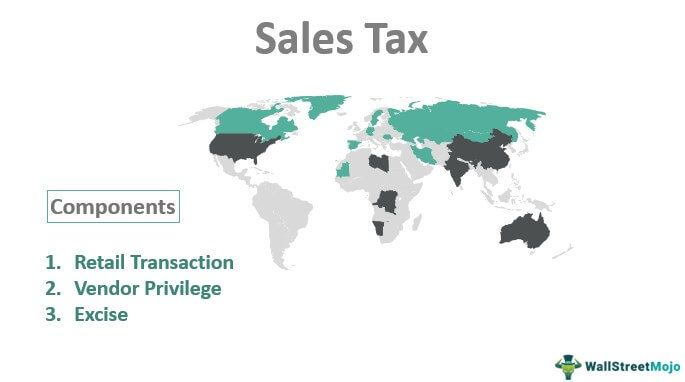Table Of Contents
What Is A Sales Tax?
The sales tax is an indirect tax levied on the sale of goods and services. This tax liability falls on the business entity, i.e., the seller, vendor, or retailer. But ultimately, the burden falls on the customer.

Sellers collect the sales tax from the customers at the point of sale and hand it over to the government. Any firm engaged in the sale or supply of goods or services in a particular state is liable to sales tax—depending on the applicable state laws and jurisdiction.
Key Takeaways
- The sales tax is an indirect form of tax imposed on goods and services at the point of sale. Although it is paid by the seller, it is later charged to the customer.
- It is applied to retail sales also. However, customers who purchase raw materials for manufacturing or resale are exempted.
- The tax amount is computed as a percentage of the net price of goods. Also, the final price of the goods after tax is the sum of the net price and sales tax amount.
How Does Sales Tax Work?
The sales tax is a type of indirect tax charged on the sale of commodities. The seller collects it from the buyer and pays it to the government—therefore, referred to as an indirect tax. It can have an immediate impact on the products and services. Often, it is seen as a regressive tax—a burden on the lower-income group.
Sometimes, governments exempt a particular product from taxes. Also, when goods are procured as raw material, they are exempt from taxes. They are considered inventory and not finished goods.
In the U.S., businesses are responsible for the tracking, collection, and submission of taxes from customers. More than 30 U.S. states have adopted economic nexus policies (including California, Florida, and Texas). Moreover, tobacco and alcohol are heavily taxed. However, some states like Montana, Alaska, Delaware, Oregon, and New Hampshire don't charge these taxes.
Revenue vs Sales Explained in Video
Types of Sales Tax
Primarily there are three subtypes:
#1 - Retail Transaction Taxes
It is the most common method of levying taxes. A tax percentage is charged on the final price of the retail goods. The seller amasses the applicable tax amount from the customer. Once collected, paying the government is the seller's responsibility.
#2 - Vendor Privilege Taxes
These taxes are imposed on retailers by the state in which they operate. So, it is like a licensing tax—for conducting business in that particular state. However, sellers may decide to pass on the burden to customers.
#3 - Consumer Excise Taxes
The excise tax is charged on goods that are hazardous to health—cigarettes, and alcohol. It is paid by producers or wholesalers. The purpose of this tax is to discourage the negative impact on society and public health.
How is Sales Tax Calculated?
The following formula is used for tax calculation:


Alternatively, one can make use of tax calculators to evaluate the product's final price.
Examples
Let us look at some examples to better understand the practical application of the concept.
Example #1
XYZ is a business operating in Washington D.C. The state levies a total sales tax of 8% (state tax of 5% + country tax of 3%). Before-tax, the product is priced at $340. What will be the selling price of the product?
Solution:

Example #2
XYZ is a business operating in Washington D.C. The state levies a total sales tax of 10% (state tax of 6% + country tax of 4%) on cosmetic products. Before taxes, the product is priced at $200; what will be the product’s final price?
Solution:

Pros and Cons
It generates considerable revenue for the government. Compared to other taxes, the collection is easy—it is attached final price paid by the buyers. Unlike income tax, tax evasion is rare. Also, a heavy sales tax on harmful goods limits consumption. Also, the burden on customers depends on quantity consumed.
There are certain drawbacks; the tax structure is very complex. It varies from state to state. For the customer, this tax increases the cost of the product. In some scenarios, customers are subject to double taxation. For example, customers have already paid taxes on personal income. When they go to spend that income, they are again taxed by the government for the product—the customer is paying the government twice for the same amount.
This tax increases the final price, and therefore, decreases manufacturers' profit margin. It is very regressive in nature—every person who purchases the product needs to pay, whether rich or poor. Unfortunately, many sellers are engaged in tax evasion practices; they collect the amount from customers but don't pay the government.
